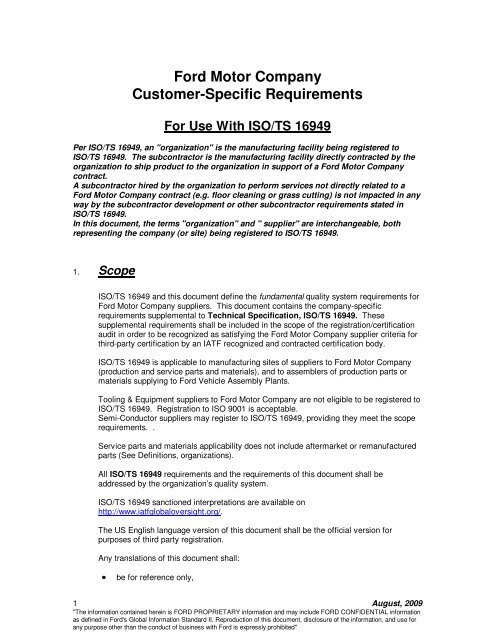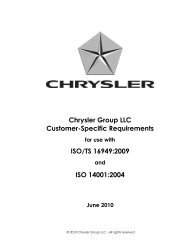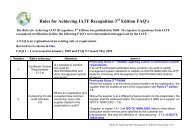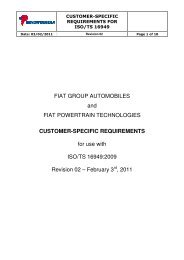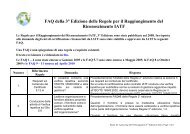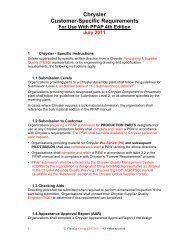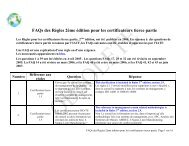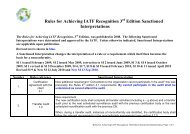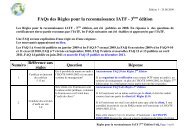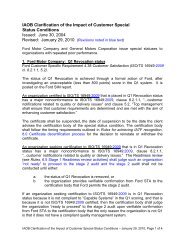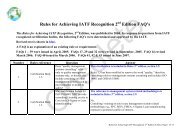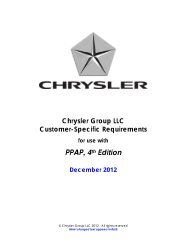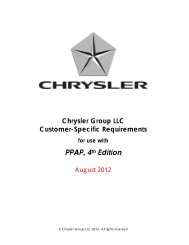Ford Motor Company Customer-Specific Requirements for use - IATF
Ford Motor Company Customer-Specific Requirements for use - IATF
Ford Motor Company Customer-Specific Requirements for use - IATF
You also want an ePaper? Increase the reach of your titles
YUMPU automatically turns print PDFs into web optimized ePapers that Google loves.
<strong>Ford</strong> <strong>Motor</strong> <strong>Company</strong><br />
<strong>Customer</strong>-<strong>Specific</strong> <strong>Requirements</strong><br />
For Use With ISO/TS 16949<br />
Per ISO/TS 16949, an "organization" is the manufacturing facility being registered to<br />
ISO/TS 16949. The subcontractor is the manufacturing facility directly contracted by the<br />
organization to ship product to the organization in support of a <strong>Ford</strong> <strong>Motor</strong> <strong>Company</strong><br />
contract.<br />
A subcontractor hired by the organization to per<strong>for</strong>m services not directly related to a<br />
<strong>Ford</strong> <strong>Motor</strong> <strong>Company</strong> contract (e.g. floor cleaning or grass cutting) is not impacted in any<br />
way by the subcontractor development or other subcontractor requirements stated in<br />
ISO/TS 16949.<br />
In this document, the terms "organization" and " supplier" are interchangeable, both<br />
representing the company (or site) being registered to ISO/TS 16949.<br />
1. Scope<br />
ISO/TS 16949 and this document define the fundamental quality system requirements <strong>for</strong><br />
<strong>Ford</strong> <strong>Motor</strong> <strong>Company</strong> suppliers. This document contains the company-specific<br />
requirements supplemental to Technical <strong>Specific</strong>ation, ISO/TS 16949. These<br />
supplemental requirements shall be included in the scope of the registration/certification<br />
audit in order to be recognized as satisfying the <strong>Ford</strong> <strong>Motor</strong> <strong>Company</strong> supplier criteria <strong>for</strong><br />
third-party certification by an <strong>IATF</strong> recognized and contracted certification body.<br />
ISO/TS 16949 is applicable to manufacturing sites of suppliers to <strong>Ford</strong> <strong>Motor</strong> <strong>Company</strong><br />
(production and service parts and materials), and to assemblers of production parts or<br />
materials supplying to <strong>Ford</strong> Vehicle Assembly Plants.<br />
Tooling & Equipment suppliers to <strong>Ford</strong> <strong>Motor</strong> <strong>Company</strong> are not eligible to be registered to<br />
ISO/TS 16949. Registration to ISO 9001 is acceptable.<br />
Semi-Conductor suppliers may register to ISO/TS 16949, providing they meet the scope<br />
requirements. .<br />
Service parts and materials applicability does not include aftermarket or remanufactured<br />
parts (See Definitions, organizations).<br />
All ISO/TS 16949 requirements and the requirements of this document shall be<br />
addressed by the organization’s quality system.<br />
ISO/TS 16949 sanctioned interpretations are available on<br />
http://www.iatfglobaloversight.org/.<br />
The US English language version of this document shall be the official version <strong>for</strong><br />
purposes of third party registration.<br />
Any translations of this document shall:<br />
• be <strong>for</strong> reference only,<br />
1 August, 2009<br />
"The in<strong>for</strong>mation contained herein is FORD PROPRIETARY in<strong>for</strong>mation and may include FORD CONFIDENTIAL in<strong>for</strong>mation<br />
as defined in <strong>Ford</strong>'s Global In<strong>for</strong>mation Standard II. Reproduction of this document, disclosure of the in<strong>for</strong>mation, and <strong>use</strong> <strong>for</strong><br />
any purpose other than the conduct of business with <strong>Ford</strong> is expressly prohibited"
• reference the English (AIAG) version as the official language,<br />
• be acceptable only if translated by organizations authorized by TS 16949 Oversight<br />
(see http://www.iatfglobaloversight.org/)<br />
• and include <strong>Ford</strong> <strong>Motor</strong> <strong>Company</strong> in the copyright statement.<br />
Copies of this document are available from <strong>Ford</strong> <strong>Motor</strong> <strong>Company</strong> at<br />
https://web.qpr.<strong>for</strong>d.com/sta/<strong>Ford</strong>specTS2nd.pdf and International Automotive<br />
Oversight Board at http://www.iatfglobaloversight.org/.<br />
2. References<br />
Note: unless otherwise noted, all references listed throughout these <strong>Ford</strong> <strong>Specific</strong><br />
<strong>Requirements</strong> refer to the latest edition.<br />
2.1 International Automotive Task Force ISO/TS 16949, Quality Systems - -<br />
Particular <strong>Requirements</strong> <strong>for</strong> the Application of ISO 9001 <strong>for</strong> automotive<br />
production and relevant service part organizations<br />
2.2 Automotive Certification Scheme <strong>for</strong> ISO/TS 16949 – Rules <strong>for</strong> achieving <strong>IATF</strong><br />
recognition.<br />
2.3 <strong>IATF</strong> Guidance to ISO/TS 16949, available through AIAG.<br />
2.4 <strong>Ford</strong> Engineering Statement of Work (ESOW), available on<br />
https://web.gfss.<strong>for</strong>d.com/<br />
2.5 Chrysler, <strong>Ford</strong> <strong>Motor</strong> <strong>Company</strong>, General <strong>Motor</strong>s Corp. Advanced Product<br />
Quality Planning and Control Plan reference manual<br />
2.6 <strong>Ford</strong> <strong>Motor</strong> <strong>Company</strong> Advanced Product Quality Planning Reporting<br />
<strong>Requirements</strong>, available through FSP (<strong>Ford</strong> Supplier Portal)<br />
https://web.qpr.<strong>for</strong>d.com/sta/APQP.html<br />
2.7 <strong>Ford</strong> Engineering CAD and Drafting Standards (FECDS) <strong>Ford</strong> internal link<br />
http://www.fecds.<strong>for</strong>d.com/. External suppliers: standards are available as<br />
specified in section 4.2 below.<br />
2.8 <strong>Ford</strong> <strong>Motor</strong> <strong>Company</strong> FMEA Handbook, are available on FSP Library Services<br />
(subsection FMEA) through<br />
https://us.library.covisint.com/LibraryServices/secured?cmd=MY_DOCUMENTS&action=docdetails&nodeID=2112<br />
2.9 Chrysler, <strong>Ford</strong> <strong>Motor</strong> <strong>Company</strong>, General <strong>Motor</strong>s Corp. Measurement Systems<br />
Analysis reference manual<br />
2.10 Chrysler, <strong>Ford</strong> <strong>Motor</strong> <strong>Company</strong>, General <strong>Motor</strong>s Corp. Statistical Process<br />
Control (SPC) reference manual.<br />
2.11 DaimlerChrysler, <strong>Ford</strong> <strong>Motor</strong> <strong>Company</strong> General <strong>Motor</strong>s Corp. Production Part<br />
Approval Process (PPAP).<br />
2.12 ISO/IEC 17021:2006 “Con<strong>for</strong>mity assessment — <strong>Requirements</strong> <strong>for</strong> bodies<br />
providing audit and certification of management systems”<br />
2 August, 2009<br />
"The in<strong>for</strong>mation contained herein is FORD PROPRIETARY in<strong>for</strong>mation and may include FORD CONFIDENTIAL in<strong>for</strong>mation<br />
as defined in <strong>Ford</strong>'s Global In<strong>for</strong>mation Standard II. Reproduction of this document, disclosure of the in<strong>for</strong>mation, and <strong>use</strong> <strong>for</strong><br />
any purpose other than the conduct of business with <strong>Ford</strong> is expressly prohibited"
2.13 MMOG (Material Management Operation Guideline), available through AIAG<br />
http://www.aiag.org/<br />
2.14 IAF GD 8:2007 “In<strong>for</strong>mative Guidance on the Transition to ISO/IEC 17021<br />
Accreditation from ISO/IEC Guide 62 and ISO/IEC Guide 66”<br />
2.15<br />
2.16 VDA (Verband der Automobilindustrie) Volume 4 Part 1 'Quality Assurance<br />
prior to Serial Application - Partnership/Processes/Methods'<br />
2.17 ISO/IEC 17025:1999 General <strong>Requirements</strong> <strong>for</strong> the Competence of Calibration<br />
and Testing Laboratories, available through ISO<br />
http://www.iso.ch/iso/en/ISOOnline.frontpage (search <strong>for</strong> "17025" in the standards<br />
search).<br />
2.18 Q1: available on https://web.qpr.<strong>for</strong>d.com/sta/Q1.html.<br />
2.19 Craftsmanship training and requirements are available through Product<br />
Development Engineering.<br />
2.20 A summary of VOPQUN-008 Quality Concern Reporting <strong>for</strong> North America<br />
available on FSP (<strong>Ford</strong> Supplier Portal<br />
https://portal.covisint.com/portal/public/_l:en/tp/fsp ), in particular available on<br />
https://web.qpr.<strong>for</strong>d.com/sta/VOPQUN008.html.<br />
2.21 VOP QUE-604 'Control of Quality and Purchased Parts and Assemblies', <strong>for</strong><br />
Europe, available through Europe STA.<br />
2.22 Global 8D system, available on FSP (https://web.quality.<strong>for</strong>d.com/g8d/)<br />
2.23 CQI-9 "Special Process: Heat Treat System Assessment", available through AIAG<br />
http://www.aiag.org/<br />
2.24 <strong>Ford</strong> <strong>Specific</strong> CQI-9 <strong>Requirements</strong><br />
https://web.qpr.<strong>for</strong>d.com/sta/CQI-9_<strong>Ford</strong>_<strong>Specific</strong>_requirements.xls<br />
The latest copies of ISO/TS 16949, PPAP, APQP, SPC, MSA and other related<br />
manuals are available from AIAG at 01-248-358-3003 and http://www.aiag.org/,<br />
and may be available through Carwin Continuous (UK) at 44-1708-861333.<br />
Additional references are listed as requirements in section 4.<br />
Some hypertext links within this document may only be accessible on FSP (<strong>Ford</strong><br />
Supplier Portal)) by organizations shipping directly to <strong>Ford</strong> <strong>Motor</strong> <strong>Company</strong><br />
(typically Tier 1). Lower tier organizations pursuing ISO/TS 16949 registration<br />
may need to gain access to FSP (<strong>Ford</strong> Supplier Portal) through a Tier 1.<br />
3 August, 2009<br />
"The in<strong>for</strong>mation contained herein is FORD PROPRIETARY in<strong>for</strong>mation and may include FORD CONFIDENTIAL in<strong>for</strong>mation<br />
as defined in <strong>Ford</strong>'s Global In<strong>for</strong>mation Standard II. Reproduction of this document, disclosure of the in<strong>for</strong>mation, and <strong>use</strong> <strong>for</strong><br />
any purpose other than the conduct of business with <strong>Ford</strong> is expressly prohibited"
3 Definitions<br />
Where inconsistent terminology exists between ISO/TS 16949 and this document, this<br />
document shall take precedence. Otherwise the definitions from ISO/TS 16949 apply to this<br />
document.<br />
3.1 Active Part<br />
An active part is one currently being supplied to the customer <strong>for</strong> original equipment<br />
or service applications. The part remains active until tooling scrap authorization is<br />
given by the appropriate customer activity. For parts with no customer-owned<br />
tooling or situations where multiple parts are made from the same tool, written<br />
confirmation from <strong>Ford</strong> Engineering and the Buyer is required to deactivate a part.<br />
3.2 Aftermarket Parts<br />
Replacement parts not procured or released by <strong>Ford</strong> <strong>Motor</strong> <strong>Company</strong> <strong>for</strong> service part<br />
applications which may or may not be produced to original equipment specifications.<br />
3.3 Capacity verification<br />
A verification methodology to demonstrate that an organization can meet the<br />
capacity planning volume requirements as defined in the Purchasing Request <strong>for</strong><br />
Quote (RFQ)<br />
3.4 Consulting<br />
For the purpose of ISO/TS 16949 and supporting documents, consulting is the<br />
provision of training, documentation development, or assistance with implementation<br />
of quality systems to a specific customer. If these activities are open to the public,<br />
advertised, and not customer specific, they are considered training rather than<br />
consulting. Other products, processes or services may be offered directly or<br />
indirectly, provided they do not compromise confidentiality or the objectivity or<br />
impartiality of its certification process or decisions [refer to IAF GD 8:2007<br />
“In<strong>for</strong>mative Guidance on the Transition to ISO/IEC 17021 Accreditation from<br />
ISO/IEC Guide 62 and ISO/IEC Guide 66” ], 2.14 of this document.<br />
3.5 <strong>Customer</strong><br />
For the purposes of ISO/TS 16949, references to “customer” in this document shall<br />
be interpreted as the entity, e.g. <strong>Ford</strong> <strong>Motor</strong> <strong>Company</strong>, which is both purchasing and<br />
receiving product from the organization complying with ISO/TS 16949.<br />
3.6 Ergonomics<br />
Ergonomics is the evaluation of the design of a product or process to assure<br />
compatibility with the capabilities of human beings. Analysis of motion refers to<br />
capabilities of people with respect to tasks (e.g. lifting, twisting, reaching) to prevent<br />
or relieve problems of strain, stress, excessive fatigue, etc. Factors involved include<br />
anatomical dimensions of the worker, placement of products to be worked upon,<br />
placement of buttons/switches, physical loads imposed on the worker, and<br />
environmental effects such as noise, vibration, lighting and space.<br />
4 August, 2009<br />
"The in<strong>for</strong>mation contained herein is FORD PROPRIETARY in<strong>for</strong>mation and may include FORD CONFIDENTIAL in<strong>for</strong>mation<br />
as defined in <strong>Ford</strong>'s Global In<strong>for</strong>mation Standard II. Reproduction of this document, disclosure of the in<strong>for</strong>mation, and <strong>use</strong> <strong>for</strong><br />
any purpose other than the conduct of business with <strong>Ford</strong> is expressly prohibited"
3.7 <strong>Ford</strong> <strong>Motor</strong> <strong>Company</strong><br />
The names "<strong>Ford</strong> <strong>Motor</strong> <strong>Company</strong>" or "<strong>Ford</strong>" refer to the corporate entity comprising<br />
all brands under <strong>Ford</strong> <strong>Motor</strong> <strong>Company</strong>.<br />
3.8 <strong>Ford</strong> Engineering<br />
<strong>Ford</strong> <strong>Motor</strong> <strong>Company</strong> Product Development Engineering, including Program and<br />
non-Program Engineering organizations.<br />
3.9 Gauge families<br />
Gauge families are measurement devices of the same type, make, and model that<br />
are <strong>use</strong>d in a similar environment (temperature, humidity, range, method of<br />
measurement, etc.).<br />
3.10 Global Product Development System<br />
GPDS is the <strong>Ford</strong> single common Product Creation Process. GPDS has<br />
replaced FPDS and is applicable to all regions and brands. GPDS<br />
Awareness Training is available at the <strong>Ford</strong> Supplier Portal<br />
https://fsp.covisint.com under Frequently Used Applications. Select “<strong>Ford</strong><br />
Learning Institute” then “GPDS Awareness Training”<br />
3.11 Initial Process Study<br />
Initial Process Studies are conducted to obtain early in<strong>for</strong>mation on the per<strong>for</strong>mance<br />
of new or revised processes relative to internal or customer requirements. In many<br />
cases, initial process studies should be conducted at several points in the evolution<br />
of new processes (e.g. at the equipment or tooling subcontractor's plant, and after<br />
installation at the organization's plant). These studies should be based on variables<br />
data evaluated using statistically valid methods.<br />
3.12 Organization<br />
Facility adding manufacturing value to production materials: providers of production<br />
or service parts, or heat treating, plating, painting or other finishing services, directly<br />
to <strong>Ford</strong> <strong>Motor</strong> <strong>Company</strong>.<br />
Note 1: For the purposes of registration under ISO/TS 16949, the "organization" is<br />
the entity normally referred to by <strong>Ford</strong> as the "supplier". <strong>Ford</strong> <strong>Motor</strong> <strong>Company</strong> will<br />
continue to <strong>use</strong> that term when negotiating with the organization.<br />
Note 2: To avoid additional confusion, although the term "supplier" is <strong>use</strong>d by<br />
ISO/TS 16949 to indicate "subcontractor", <strong>Ford</strong> <strong>Motor</strong> <strong>Company</strong> will continue to <strong>use</strong><br />
the term "subcontractor" in its normal usage.<br />
Note 3: "Design responsible Suppliers" also provide engineering services. Program<br />
specific Engineering Statement of Work defines engineering responsibilities.<br />
Note 4: Sequencing wareho<strong>use</strong>s and other facilities not adding manufacturing value<br />
to the product are not eligible <strong>for</strong> stand-alone registration to ISO/TS 16949.<br />
3.13 PPM (Part Per Million quality metrics)<br />
A method of stating the per<strong>for</strong>mance of a process in terms of actual noncon<strong>for</strong>ming<br />
material. PPM data can be <strong>use</strong>d to prioritize corrective actions.<br />
5 August, 2009<br />
"The in<strong>for</strong>mation contained herein is FORD PROPRIETARY in<strong>for</strong>mation and may include FORD CONFIDENTIAL in<strong>for</strong>mation<br />
as defined in <strong>Ford</strong>'s Global In<strong>for</strong>mation Standard II. Reproduction of this document, disclosure of the in<strong>for</strong>mation, and <strong>use</strong> <strong>for</strong><br />
any purpose other than the conduct of business with <strong>Ford</strong> is expressly prohibited"
3.14 Process Approach<br />
A method to measure and improve organizational per<strong>for</strong>mance in terms of customer<br />
metrics and specifications.<br />
3.15 Quality Indices<br />
See Statistical Process Control reference manual.<br />
3.16 Shall<br />
A mandatory requirement.<br />
3.17 Should<br />
A recommendation.<br />
3.18 SIM<br />
Supplier Improvement Metrics – supplier per<strong>for</strong>mance measurements available<br />
through FSP (<strong>Ford</strong> Supplier Portal<br />
https://portal.covisint.com/portal/public/_l:en/tp/fsp).<br />
3.19 Site<br />
An organization's (see definition 3.12) individual manufacturing location which has<br />
material / part input and part output.<br />
NOTE<br />
Includes assemblers and Vehicle Assembly Plants<br />
3.20 SREA<br />
Supplier Request <strong>for</strong> Engineering Approval.<br />
3.21 STA<br />
Supplier Technical Assistance – <strong>Ford</strong> <strong>Motor</strong> <strong>Company</strong>'s team dedicated to assist in<br />
the development of supplier processes.<br />
3.22 Subcontractor<br />
Provider of production materials, or production or service parts, directly to an<br />
organization complying with ISO/TS16949. Also included are providers of heat<br />
treating, painting, plating or other finishing services to organizations.<br />
3.23 Value-Added Production Processes<br />
Manufacturing activities or operations <strong>for</strong> which a customer would be willing to pay, if<br />
given the option.<br />
3.24 Final <strong>Customer</strong><br />
Owner of the vehicle sold through commercial or private transaction.<br />
3.25 8D Process<br />
A disciplined process which addresses problem solving in a methodical and<br />
analytical method, addressing root ca<strong>use</strong>s to eliminate the source(s) of the concern.<br />
6 August, 2009<br />
"The in<strong>for</strong>mation contained herein is FORD PROPRIETARY in<strong>for</strong>mation and may include FORD CONFIDENTIAL in<strong>for</strong>mation<br />
as defined in <strong>Ford</strong>'s Global In<strong>for</strong>mation Standard II. Reproduction of this document, disclosure of the in<strong>for</strong>mation, and <strong>use</strong> <strong>for</strong><br />
any purpose other than the conduct of business with <strong>Ford</strong> is expressly prohibited"
4 <strong>Requirements</strong><br />
Third-Party Registration <strong>Requirements</strong><br />
Unless waived in writing by <strong>Ford</strong> <strong>Motor</strong> <strong>Company</strong>, "tier 1 suppliers"* to <strong>Ford</strong> <strong>Motor</strong> <strong>Company</strong><br />
<strong>for</strong> production or service parts or services shall be third party registered 1 to ISO/TS 16949.<br />
Additional details are provided in Q1, see https://web.qpr.<strong>for</strong>d.com/sta/Q1.html.<br />
The Scope (section 1) of ISO/TS 16949 (also see 4.1 of this document) specifies the types of<br />
organizations appropriate <strong>for</strong> an ISO/TS 16949 registration.<br />
The ISO/TS 16949 Guidance provides suggestions in the implementation of ISO/TS 16949.<br />
* Note: In this context, "Tier 1 supplier" refers to an organization's manufacturing site directly<br />
contracted by <strong>Ford</strong> <strong>Motor</strong> <strong>Company</strong> to ship product directly to a <strong>Ford</strong> <strong>Motor</strong> <strong>Company</strong> facility.<br />
4.1 Scope of Quality Manual (ISO/TS 16949 cl. 4.2.2)<br />
While it is technically feasible to register only one part of an organization's facility<br />
(one product line or area) to ISO/TS 16949, this type of limited scope is not<br />
permitted <strong>for</strong> the demonstration of capable quality systems in Q1.<br />
For Q1, the entire facility (producing automotive products <strong>for</strong> customers subscribing<br />
to ISO/TS 16949 and eligible <strong>for</strong> ISO/TS 16949 registration) must be registered.<br />
Different customer specifics may apply to each product line, but all automotive<br />
manufacturing lines must meet the requirements of ISO/TS 16949.<br />
4.2 Control of documents (ISO/TS 16949 cl. 4.2.3)<br />
Where the organization <strong>use</strong>s <strong>Ford</strong> documents / instructions or other documents of<br />
external origin, the organization ensures that the appropriate revision level is <strong>use</strong>d –<br />
this is either the most current version available from FSP (<strong>Ford</strong> Supplier Portal<br />
https://portal.covisint.com/portal/public/_l:en/tp/fsp ).or as specified by <strong>Ford</strong> <strong>Motor</strong><br />
<strong>Company</strong>.<br />
Note: Engineering Standards may be obtained from the following sources:<br />
In<strong>for</strong>mation Handling Services<br />
Mail Stop C102, 15 Inverness Way East, Englewood, CO 80112-5776 USA<br />
e-mail info@ihs.com, web site http://www.ihs.com/<br />
Telephone: North America: 1-800-716-3447, global: 1-303-397-2896,<br />
Trubiquity.<br />
1688 Star Batt Drive, Rochester Hills, MI 48309 USA<br />
Telephone: USA 1-248 601-7160 Please see the web site <strong>for</strong> other regional<br />
telephone numbers<br />
email: learnmore@trubiquity.com, web site http://www.trubiquity.com/).<br />
1 Registrars acceptable <strong>for</strong> ISO/TS 16949 3 rd party audits are listed on<br />
http://www.iatfglobaloversight.org/<br />
7 August, 2009<br />
"The in<strong>for</strong>mation contained herein is FORD PROPRIETARY in<strong>for</strong>mation and may include FORD CONFIDENTIAL in<strong>for</strong>mation<br />
as defined in <strong>Ford</strong>'s Global In<strong>for</strong>mation Standard II. Reproduction of this document, disclosure of the in<strong>for</strong>mation, and <strong>use</strong> <strong>for</strong><br />
any purpose other than the conduct of business with <strong>Ford</strong> is expressly prohibited"
ILI Infodisk Inc. North America<br />
610 Winters Avenue Paramus NJ 07652<br />
Telephone: North America 1-201-986-1131<br />
e-mail uspubsales@saiglobal.com, web site: http://www.ili-info.com/.<br />
ILI Index Ho<strong>use</strong>, Outside North America<br />
Ascot Ho<strong>use</strong>, Berks, SL5 7EU, United Kingdom<br />
Telephone: +44(0) 1344 636400<br />
email: standards@saiglobal.com, web page http://www.ili.co.uk./en/<br />
If any standards are not available through the above sources, organizations should<br />
contact <strong>Ford</strong> Engineering, or <strong>for</strong> organizations with <strong>Ford</strong> Intranet access,<br />
http://www.rlis.<strong>for</strong>d.com/cgi-bin/standards/iliaccess.pl/ may provide a more<br />
complete inventory.<br />
The heat treat standard HTX is available through HIS Global Engineering<br />
Documents http://www.global.ihs.com<br />
or 1-800-854-7179 (US only).<br />
4.3 Engineering <strong>Specific</strong>ations (ISO/TS 16949 cl. 4.2.3.1, 7.3.5)<br />
Heat Treat Assessment <strong>Requirements</strong><br />
Organizations and suppliers providing heat treated product and heat-treating<br />
services shall demonstrate compliance to CQI-9 "Special Process: Heat Treat<br />
System Assessment" Second Edition and <strong>Ford</strong> <strong>Specific</strong> CQI-9 requirements<br />
(available through https://web.qpr.<strong>for</strong>d.com/sta/CQI-<br />
9_<strong>Ford</strong>_<strong>Specific</strong>_requirements.xls). Compliance with CQI-9 and <strong>Ford</strong> <strong>Specific</strong> CQI-<br />
9 requirements will ensure compliance to <strong>Ford</strong>'s heat treat standard W-HTX. For<br />
reference, W-HTX is available through the standards providers listed in section 4.2<br />
of this document; CQI-9 is available through AIAG http://www.aiag.org/ .<br />
CQI-9 Special Process: Heat Treat System Assessment<br />
• All heat-treating processes at each supplier and organization manufacturing site<br />
shall be assessed annually (at all tier levels), using the CQI-9 "Special Process:<br />
Heat Treat System Assessment" (HTSA) Second Edition, available through<br />
AIAG, http://www.aiag.org/ and <strong>Ford</strong> <strong>Specific</strong> CQI-9 requirements (available<br />
through https://web.qpr.<strong>for</strong>d.com/sta/CQI-9_<strong>Ford</strong>_<strong>Specific</strong>_requirements.xls).<br />
Assessments must also be conducted following any heat treat process and/or<br />
heat treat equipment changes. All heat treat processes are to be assessed,<br />
including all heat treat processes listed in CQI-9 as well as brazing and sintering,<br />
as noted in <strong>Ford</strong> <strong>Specific</strong> CQI-9 requirements. Where items in the CQI-9 heat<br />
treat assessment are identified as being "not satisfactory" or "needs immediate<br />
action" the organization shall address the root ca<strong>use</strong>s in an action plan. This<br />
action plan must also have a risk containment action that immediately protects<br />
all components being shipped to <strong>Ford</strong>, regardless of tier level. Where "needs<br />
immediate action" is assessed, containment action is required.<br />
• The heat treat assessment can be either 1st or 2nd party, but must be conducted<br />
by a qualified assessor.<br />
Note: A qualified assessor is one that is knowledgeable in heat treat<br />
processes. This knowledge can be acquired through education, training,<br />
or work experience. The organization or heat treat supplier should<br />
develop specific criteria <strong>for</strong> this heat treat process knowledge.<br />
The organization shall maintain the 2 prior annual assessment reports and related<br />
8 August, 2009<br />
"The in<strong>for</strong>mation contained herein is FORD PROPRIETARY in<strong>for</strong>mation and may include FORD CONFIDENTIAL in<strong>for</strong>mation<br />
as defined in <strong>Ford</strong>'s Global In<strong>for</strong>mation Standard II. Reproduction of this document, disclosure of the in<strong>for</strong>mation, and <strong>use</strong> <strong>for</strong><br />
any purpose other than the conduct of business with <strong>Ford</strong> is expressly prohibited"
in<strong>for</strong>mation at the organization's site and make them available to STA upon request.<br />
Heat Treat assessments conducted by the organization, heat treat suppliers, or <strong>Ford</strong><br />
demonstrating compliance to CQI-9 and <strong>Ford</strong> <strong>Specific</strong> CQI-9 requirements do not<br />
relieve the organization of full responsibility <strong>for</strong> the quality of supplied product.<br />
To reduce the risk of embrittlement, heat-treated steel components shall con<strong>for</strong>m to<br />
the requirements of <strong>Ford</strong> Engineering Material <strong>Specific</strong>ation WSS-M99A3-A, also<br />
available per section 4.2 of this document.<br />
4.4 Control of Records (ISO/TS 16949 cl. 4.2.4)<br />
Production part approvals, tooling records, purchase orders and amendments shall<br />
be maintained <strong>for</strong> the length of time that the part (or family of parts) is active <strong>for</strong><br />
production and service requirements plus one calendar year unless otherwise<br />
specified by <strong>Ford</strong> <strong>Motor</strong> <strong>Company</strong> (see Definitions, 3.1).<br />
NOTE: All <strong>Ford</strong> <strong>Motor</strong> <strong>Company</strong> purchase orders/amendments are included in this<br />
requirement.<br />
Organization purchase orders/amendments <strong>for</strong> <strong>Ford</strong>-owned tooling are also included<br />
in this requirement.<br />
Records of inspection shall be maintained <strong>for</strong> each customer specification, unless<br />
waived in writing by STA. The actual test result (variable or attribute) shall be<br />
recorded. Simple pass/fail records of inspection are not acceptable <strong>for</strong> variable<br />
measurements.<br />
Production inspection and test records (e.g. control charts, inspection and test<br />
results) shall be retained <strong>for</strong> one calendar year after the year in which they were<br />
created.<br />
Records of internal quality system audits and management review shall be retained<br />
<strong>for</strong> three years.<br />
Retention periods longer than those specified above may be specified by an<br />
organization in its procedures.<br />
Specified retention requirements may be revised at the direction of <strong>Ford</strong> <strong>Motor</strong><br />
<strong>Company</strong> Office of General Counsel.<br />
These requirements do not supersede any regulatory requirements.<br />
4.5 <strong>Customer</strong> focus (ISO/TS 16949 cl. 5.2, 8.2.4, 8.5.1)<br />
The organization shall demonstrate enhanced customer satisfaction by meeting the<br />
continuous improvement requirements of Q1, as demonstrated in the organization's<br />
QOS (Quality Operating System).<br />
The organization shall <strong>use</strong> the QOS Assessment in the development of its QOS –<br />
the QOS Assessment is available on https://web.qpr.<strong>for</strong>d.com/sta/3219741.pdf,<br />
unless otherwise approved by STA.<br />
9 August, 2009<br />
"The in<strong>for</strong>mation contained herein is FORD PROPRIETARY in<strong>for</strong>mation and may include FORD CONFIDENTIAL in<strong>for</strong>mation<br />
as defined in <strong>Ford</strong>'s Global In<strong>for</strong>mation Standard II. Reproduction of this document, disclosure of the in<strong>for</strong>mation, and <strong>use</strong> <strong>for</strong><br />
any purpose other than the conduct of business with <strong>Ford</strong> is expressly prohibited"
4.6 <strong>Customer</strong> Representative (ISO/TS 16949 cl. 5.5.2.1)<br />
The organization shall notify <strong>Ford</strong> <strong>Motor</strong> <strong>Company</strong> Supplier Technical Assistance<br />
within 10 working days of any changes to senior management responsible <strong>for</strong> Quality<br />
or company ownership.<br />
4.7 Management Review (ISO/TS 16949 cl 5.6, 5.1)<br />
The organization management shall hold monthly QOS (Quality Operating System)<br />
per<strong>for</strong>mance meetings as specified in the Q1 Manufacturing Site Assessment<br />
available on https://web.qpr.<strong>for</strong>d.com/sta/Q1.html. The results of these QOS<br />
reviews shall be integral to the senior management reviews.<br />
Note: the frequency of the Manufacturing Site Assessments is specified by the Q1<br />
requirements, available on https://web.qpr.<strong>for</strong>d.com/sta/Q1.html.<br />
Note: the management review need not be held as one meeting, but may be a series<br />
of meetings, covering each of the metrics monthly.<br />
4.8 Management Review Input (ISO/TS 16949 cl 5.6.2)<br />
Management review input must also include the Q1 Manufacturing Site Assessment<br />
results<br />
4.9 Training (ISO/TS 16949 cl. 6.2.2.2, 6.2.2.3, 6.2.2.4)<br />
The organization shall ensure that only trained and qualified personnel are involved<br />
in all aspects of the manufacture or design (as appropriate) of <strong>Ford</strong> <strong>Motor</strong> <strong>Company</strong><br />
parts. The training shall include the appropriate <strong>Ford</strong> systems.<br />
<strong>Ford</strong> training opportunities are available through <strong>Ford</strong> Supplier Learning Institute<br />
https://web.fsli.<strong>for</strong>d.com/.<br />
Personnel are to be trained to the current processes and requirements, e.g. trained<br />
to the published version of process requirements. Records of training are to be<br />
maintained <strong>for</strong> 3 years from the date of the training.<br />
4.10 Provision of resources (ISO/TS 16949 cl. 6.2.2.2, 6.3.1, 6.2.2,<br />
6.2.2.1)<br />
When considering a request <strong>for</strong> quote, the organization must account <strong>for</strong> and be able<br />
to apply all necessary resources (trained personnel and equipment) to complete the<br />
purchase requirements to <strong>Ford</strong>'s satisfaction.<br />
10 August, 2009<br />
"The in<strong>for</strong>mation contained herein is FORD PROPRIETARY in<strong>for</strong>mation and may include FORD CONFIDENTIAL in<strong>for</strong>mation<br />
as defined in <strong>Ford</strong>'s Global In<strong>for</strong>mation Standard II. Reproduction of this document, disclosure of the in<strong>for</strong>mation, and <strong>use</strong> <strong>for</strong><br />
any purpose other than the conduct of business with <strong>Ford</strong> is expressly prohibited"
4.11 Plant, Facility and Equipment Planning (ISO/TS 16949 cl. 6.3.1,<br />
7.3.3.2, 5.1.1)<br />
Manufacturing Flow<br />
The organization shall have evidence of Lean manufacturing implementation plans<br />
as defined in the link below and in the Q1 Manufacturing Site Assessment.<br />
In<strong>for</strong>mation on <strong>Ford</strong> Lean manufacturing principles is available through<br />
https://web.lean.<strong>for</strong>d.com/<br />
4.12 Contingency Plans (ISO/TS cl 6.3.2)<br />
The Organization shall notify the <strong>Ford</strong> receiving plant, the buyer and the STA<br />
engineer within 24 hours of organization production interruption. The nature of the<br />
problem shall be communicated to <strong>Ford</strong> and immediate actions taken to assure<br />
supply of product to <strong>Ford</strong>.<br />
Note: production interruption is defined as an inability to meet the <strong>Ford</strong> specified<br />
production capacity volume.<br />
4.13 Cleanliness of Premises (ISO/TS 16949 cl. 6.4.2)<br />
Product Cleanliness<br />
Part dunnage is included in this requirement.<br />
4.14 Planning of Product Realization (ISO/TS 16949 cl. 7.1, 7.3.1,<br />
4.2.1d, 7.3.4.1, 5.4.1, 5.4.2)<br />
Appropriate to the supplier's responsibilities, the organization shall meet the<br />
requirements of the Engineering Statement of Work (available on<br />
https://web.gfss.<strong>for</strong>d.com )<br />
For all supplier sites with parts launching under the Global Product<br />
Development System (GPDS).<br />
Effective 30 th January, 2008, the Advanced Product Quality Planning <strong>for</strong>m version<br />
3.2 or 3.1 (Pan Brand) is replaced by Supplier APQP/PPAP Readiness Assessment<br />
– Schedule A, see https://web.qpr.<strong>for</strong>d.com/sta/APQP.html and<br />
https://web.qpr.<strong>for</strong>d.com/sta/GPDSSupplierEngagement.html on <strong>Ford</strong> Supplier<br />
Portal.<br />
Note: There may be vehicle programs already underway where the APQP versions<br />
3.1 and 3.2 Pan Brand (see https://web.qpr.<strong>for</strong>d.com/sta/FPDSLaunch.html) are<br />
currently in <strong>use</strong> and this should continue unless otherwise authorized by <strong>Ford</strong> STA.<br />
When the organization is also sourced with the production of prototypes, effective<br />
<strong>use</strong> should be made of data from prototype fabrication to plan the production<br />
11 August, 2009<br />
"The in<strong>for</strong>mation contained herein is FORD PROPRIETARY in<strong>for</strong>mation and may include FORD CONFIDENTIAL in<strong>for</strong>mation<br />
as defined in <strong>Ford</strong>'s Global In<strong>for</strong>mation Standard II. Reproduction of this document, disclosure of the in<strong>for</strong>mation, and <strong>use</strong> <strong>for</strong><br />
any purpose other than the conduct of business with <strong>Ford</strong> is expressly prohibited"
process. <strong>Specific</strong> requirements and supporting data, Percent Inspection points that<br />
Satisfy Tolerance (PIST) and Percent Indices which are Process Capable (PIPC)<br />
may be required by Supplier Technical Assistance to support prototype vehicle<br />
evaluations. See the Glossary of this document <strong>for</strong> definitions of these terms.<br />
4.15 Acceptance Criteria (ISO/TS 16949 cl. 7.1.2)<br />
For additional in<strong>for</strong>mation, see Tables A and B of this document.<br />
4.16 <strong>Customer</strong> related processes (ISO/TS 16949 cl. 7.2.1)<br />
<strong>Ford</strong> requires all manufacturing sites to report all materials per WSS-M99P9999-A1,<br />
as noted in PPAP, <strong>Ford</strong> <strong>Specific</strong> Instructions.<br />
These requirements are detailed on FSP (environmental)..<br />
4.17 Review of requirements related to the product – supplemental<br />
(ISO/TS 16949 cl. 7.2.2.1)<br />
The customer authorization <strong>for</strong> waiving <strong>for</strong>mal review may be obtained from the<br />
Buyer, and when appropriate, <strong>Ford</strong> Engineering.<br />
4.18 Manufacturing Feasibility (ISO/TS 16949 cl. 7.2.2.2)<br />
Manufacturing feasibility reviews, e.g. APQP appendix E, shall include all supplier<br />
and <strong>Ford</strong> Engineering organizations, as appropriate.<br />
Product volume change requests from <strong>Ford</strong> <strong>Motor</strong> <strong>Company</strong> increasing volume by<br />
20% or more over the previously verified volume capability shall require full volume<br />
feasibility studies. (APQP appendix E, or capacity verification may be required).<br />
4.19 <strong>Customer</strong> communication - supplemental (ISO/TS 16949 cl.<br />
7.2.3.1)<br />
Assistance in C3P or legacy data system compatibility with <strong>Ford</strong> CAD systems is<br />
available through https://web.c3p.<strong>for</strong>d.com/index.html<br />
4.20 Multidisciplinary approach (ISO/TS 16949 cl. 7.3.1.1, 7.3.3.2)<br />
FMEA and Control Plan Approvals<br />
• Process FMEA(s) and Control plan(s) <strong>for</strong> inverted delta component(s) require<br />
<strong>Ford</strong> Engineering & STA approval.<br />
12 August, 2009<br />
"The in<strong>for</strong>mation contained herein is FORD PROPRIETARY in<strong>for</strong>mation and may include FORD CONFIDENTIAL in<strong>for</strong>mation<br />
as defined in <strong>Ford</strong>'s Global In<strong>for</strong>mation Standard II. Reproduction of this document, disclosure of the in<strong>for</strong>mation, and <strong>use</strong> <strong>for</strong><br />
any purpose other than the conduct of business with <strong>Ford</strong> is expressly prohibited"
• Design FMEA(s) <strong>for</strong> inverted delta component(s) prepared by design responsible<br />
suppliers require <strong>Ford</strong> Engineering approval.<br />
• All FMEA and control plan approvals are required prior to PPAP submission,<br />
regardless of PPAP level.<br />
Approval of revisions to these documents after initial acceptance per the above is<br />
also required.<br />
<strong>Ford</strong> reserves the right to require approval of FMEA and/or control plans <strong>for</strong> any part<br />
from any supplier.<br />
FMEAs<br />
The organization shall prepare documented process FMEAs <strong>for</strong> all the <strong>Ford</strong> parts it<br />
manufactures.<br />
Where the organization is responsible <strong>for</strong> design, the organization shall prepare<br />
documented design FMEAs <strong>for</strong> all <strong>Ford</strong> parts it designs.<br />
FMEAs may be written <strong>for</strong> families of parts, where typically the only difference in the<br />
parts is dimensional, not <strong>for</strong>m, application or function. However, in all cases, <strong>use</strong> of<br />
family process FMEAs shall be approved by STA and <strong>use</strong> of family design FMEAs<br />
shall be approved by <strong>Ford</strong> Engineering.<br />
Suppliers are to provide copies of FMEA documents to <strong>Ford</strong> <strong>Motor</strong> <strong>Company</strong> upon<br />
request.<br />
Suppliers shall comply with the <strong>Ford</strong> FMEA Handbook requirements see FSP Library<br />
Services https://portal.covisint.com/portal/public/_l:en/tp/fsp – (subsection<br />
FMEA). Suppliers complying with the <strong>Ford</strong> FMEA Handbook will meet the FMEA and<br />
related requirements of the Q1 Manufacturing Site Assessment. .<br />
Control Plans<br />
All <strong>Ford</strong> <strong>Motor</strong> <strong>Company</strong> parts shall have Control Plans (or Dynamic Control Plans –<br />
DCP if required by Powertrain). See https://web.qpr.<strong>for</strong>d.com/sta/Q1.html Q1 site<br />
assessment, ISO/TS 16949 Annex A, and AIAG APQP <strong>for</strong> Control Plan<br />
requirements, and APQP Appendix G <strong>for</strong> DCP in<strong>for</strong>mation.<br />
Design and process controls shall focus on prevention rather than detection and<br />
correction.<br />
Repaired and/or reworked product shall be re-inspected in accordance with the<br />
Control Plan and/or documented procedure.<br />
Supplier Notification Change of Monitoring of Special Characteristics<br />
When data from control charts and ES tests indicate a high degree of capability, the<br />
organization may request a revision to the testing and inspection requirements <strong>for</strong><br />
parts with Special Characteristics (see Glossary). <strong>Ford</strong> Engineering and Supplier<br />
Technical Assistance approval of a revised Control Plan will authorize the revision.<br />
Approval shall be obtained prior to implementing the change. The same approach<br />
shall be <strong>use</strong>d to replace finished product inspection/testing with upstream controls.<br />
The organization shall submit requests <strong>for</strong> approval via the SREA (Supplier Request<br />
<strong>for</strong> Engineering Approval).<br />
4.20.1 Control Item ( ∇ ) Fasteners<br />
The following control shall be included in the Control Plan <strong>for</strong> fasteners<br />
that are Control Items:<br />
4.20.1.1 Material Analysis - Heat-Treated Parts<br />
Prior to release of metal from an identified mill heat, a sample<br />
from at least one coil or bundle of wire, rod, strip, or sheet steel<br />
13 August, 2009<br />
"The in<strong>for</strong>mation contained herein is FORD PROPRIETARY in<strong>for</strong>mation and may include FORD CONFIDENTIAL in<strong>for</strong>mation<br />
as defined in <strong>Ford</strong>'s Global In<strong>for</strong>mation Standard II. Reproduction of this document, disclosure of the in<strong>for</strong>mation, and <strong>use</strong> <strong>for</strong><br />
any purpose other than the conduct of business with <strong>Ford</strong> is expressly prohibited"
shall be analyzed and tested to determine its con<strong>for</strong>mance to<br />
specifications <strong>for</strong> chemical composition and quenched hardness.<br />
A sample from each additional coil or bundle in the heat shall be<br />
tested <strong>for</strong> either chemical composition or quenched hardness.<br />
The results shall be documented and referenced to the steel<br />
supplier's mill heat number.<br />
This requirement applies to both purchased material and<br />
material produced by the organization.<br />
Note: external material test facilities <strong>use</strong>d shall meet the<br />
requirements specified in section 4.36 of this document<br />
(Laboratory <strong>Requirements</strong>).<br />
4.20.1.2 Material Analysis - Non Heat-Treated Parts<br />
The identification of each coil or bundle of wire, rod, strip, or<br />
sheet steel shall be visually checked to determine that the mill<br />
heat number agrees with the steel supplier's mill analysis<br />
document and applicable specifications. Each coil or bundle<br />
shall be tested <strong>for</strong> hardness and other applicable physical<br />
properties.<br />
4.20.1.3 Lot Traceability<br />
Lot Traceability shall be maintained.<br />
4.21 Special Characteristics (ISO/TS 16949 cl. 7.3.2.3, 7.2.1.1)<br />
Symbols<br />
The organization is to contact <strong>Ford</strong> Engineering to obtain concurrence <strong>for</strong> the <strong>use</strong> of<br />
<strong>Ford</strong> <strong>Motor</strong> <strong>Company</strong> special characteristics symbols defined in the glossary of this<br />
document .<br />
For internal <strong>use</strong>, the organization may develop its own special characteristics<br />
symbols.<br />
<strong>Ford</strong> Designated Special Characteristics<br />
Critical Characteristic ( ∇ ) Parts<br />
<strong>Ford</strong> designated Control Item Parts are selected products identified by <strong>Ford</strong><br />
Engineering, concurred by <strong>Ford</strong> manufacturing and identified on drawings and<br />
specifications with an inverted delta ( ∇ ) preceding the part and/or material number.<br />
Control Item products have Critical Characteristics (refer to the Glossary of this<br />
document) that may affect safe vehicle operation and/or compliance with<br />
government regulations. Unique symbols identifying safety and regulatory<br />
characteristics on components designed by other companies (e.g. Mazda) are<br />
equivalent to the inverted delta ( ∇ ) symbol. Examples are the Mazda "A" and<br />
"AR" symbols or special fastener base part numbers beginning with "W9" which are<br />
to be treated as inverted delta.<br />
Critical Characteristics <strong>for</strong> fasteners may be designated by methods defined in <strong>Ford</strong><br />
Engineering Fastener <strong>Specific</strong>ations available through <strong>Ford</strong> Global Materials and<br />
Fastener Standards, or the specification providers listed in 4.2 of this document.<br />
Other Special Characteristics<br />
Significant, High Impact and Pass Through Characteristics are described in the<br />
glossary of this document.<br />
14 August, 2009<br />
"The in<strong>for</strong>mation contained herein is FORD PROPRIETARY in<strong>for</strong>mation and may include FORD CONFIDENTIAL in<strong>for</strong>mation<br />
as defined in <strong>Ford</strong>'s Global In<strong>for</strong>mation Standard II. Reproduction of this document, disclosure of the in<strong>for</strong>mation, and <strong>use</strong> <strong>for</strong><br />
any purpose other than the conduct of business with <strong>Ford</strong> is expressly prohibited"
4.22 Design and Development Review (ISO/TS 16949 cl. 7.3.4, 7.3.1,<br />
7.3.6.1)<br />
The organization shall <strong>use</strong> GPDS (Global Product Development System) (unless<br />
approved otherwise in writing by <strong>Ford</strong> Engineering) when reviewing product design<br />
and development stages. In<strong>for</strong>mation on GPDS is available through FSP (<strong>Ford</strong><br />
Supplier Portal https://fsp.covisint.com under Frequently Used Applications ).<br />
Product Development<br />
For Inverted Delta ( ∇ ) parts, design responsible suppliers shall include <strong>Ford</strong><br />
Engineering and Assembly / Manufacturing in GPDS milestone design reviews, as<br />
appropriate.<br />
Where feasible, design responsible suppliers shall include <strong>Ford</strong> Engineering and<br />
<strong>Ford</strong> Assembly and/or Manufacturing in design reviews <strong>for</strong> all <strong>Ford</strong> parts.<br />
4.23 Design and Development Verification (ISO/TS 16949 cl. 7.3.5)<br />
The organization shall per<strong>for</strong>m design verification to show con<strong>for</strong>mance with the<br />
appropriate <strong>Ford</strong> Vehicle Design <strong>Specific</strong>ation(s) (VDS) and System Design<br />
<strong>Specific</strong>ation(s) (SDS). Verification methods shall be recorded with the test results.<br />
VDSs and SDSs are available from <strong>Ford</strong> Engineering.<br />
4.24 Prototype Program (ISO/TS 16949 cl. 7.3.6.2)<br />
The organization is responsible <strong>for</strong> the quality of the parts it produces and <strong>for</strong> any<br />
subcontracted services, including subcontractors specified by <strong>Ford</strong> <strong>Motor</strong> <strong>Company</strong>.<br />
This applies to all phases of product development, including prototypes. Individual<br />
Statements of Work may specify alternate responsibilities. See GPDS <strong>for</strong> additional<br />
in<strong>for</strong>mation on prototype programs on <strong>Ford</strong> Supplier Portal.<br />
The organization shall request <strong>Ford</strong> <strong>Motor</strong> <strong>Company</strong> confirmation of the need <strong>for</strong> a<br />
prototype program control plan.<br />
4.25 Product Approval Process (ISO/TS 16949 cl. 7.3.6.3, )<br />
Production Part Approval Process<br />
The organization shall comply with the AIAG Production Part Approval Process<br />
(PPAP) manual.<br />
The organization is responsible <strong>for</strong> managing PPAP <strong>for</strong> all tiers of subcontractors per<br />
the Q1 requirements.<br />
Subcontractors are to meet all requirements of PPAP.<br />
For organizations with a <strong>Ford</strong> designated PPAP level 2 through 5, any PPAP<br />
package submitted to <strong>Ford</strong> shall contain the subcontractor PPAP in<strong>for</strong>mation or have<br />
the subcontractor PPAP in<strong>for</strong>mation available <strong>for</strong> review.<br />
PPAP level 1 organizations are not required to submit PPAP packages to <strong>Ford</strong>,<br />
unless specifically requested by <strong>Ford</strong>.<br />
15 August, 2009<br />
"The in<strong>for</strong>mation contained herein is FORD PROPRIETARY in<strong>for</strong>mation and may include FORD CONFIDENTIAL in<strong>for</strong>mation<br />
as defined in <strong>Ford</strong>'s Global In<strong>for</strong>mation Standard II. Reproduction of this document, disclosure of the in<strong>for</strong>mation, and <strong>use</strong> <strong>for</strong><br />
any purpose other than the conduct of business with <strong>Ford</strong> is expressly prohibited"
Consistent with Q1 Manufacturing Site Assessment Expectations<br />
https://web.qpr.<strong>for</strong>d.com/sta/Q1_Site_Assessment_Evaluation_Matrix.xls ,<br />
section 4 (PPAP and run-at-rate review), all design changes, including those<br />
proposed by subcontractors, shall have written approval per PPAP prior to<br />
production implementation.<br />
Per PPAP, all organization initiated design change requests shall be made via<br />
WERS, unless the organization or subcontractor does not have access to WERS.<br />
Process change requests and design requests without WERS shall be managed<br />
using the SREA process.<br />
All proposed design and process changes, including any changes of or at supplier<br />
site(s) must be submitted to <strong>Ford</strong> <strong>for</strong> approval prior to implementation per the SREA<br />
process.<br />
Full PPAP approval by STA will not be granted if the part is under WERS Alert.<br />
Only when the Alert has been cleared can full STA approval be given.<br />
”Run-at-Rate” When specified by <strong>Ford</strong>, PPAP "run-at-rate" requirements are met<br />
by demonstrating "Production verification", Phase 2 of Phased PPAP<br />
implementation. Contact Supplier Technical Assistance <strong>for</strong> the Phased PPAP<br />
methodology.<br />
4.26 Regulations (ISO/TS 16949 cl. 7.4.1.1)<br />
Applicable regulations shall include international requirements <strong>for</strong> export vehicles as<br />
specified by <strong>Ford</strong> <strong>Motor</strong> <strong>Company</strong>, e.g. plastic part marking (E-4 drafting standard –<br />
WSS-M99P9999-A1 and European End of Life of Vehicle (ELV) –available on FSP<br />
(<strong>Ford</strong> Supplier Portal https://portal.covisint.com/portal/public/_l:en/tp/fsp )..<br />
Material reporting requirements <strong>for</strong> ELV are specified by WSS-M99P9999-A1.<br />
4.27 Subcontractor Development (ISO/TS 16949 7.4.1.2)<br />
“Goal of supplier con<strong>for</strong>mity with [ISO/TS 16949]” may be met by either of the<br />
following:<br />
4.27.1 Subcontractors to achieve accredited third party certification to ISO/TS<br />
16949, or the current version of ISO 9000.<br />
4.27.2 Successful assessments of the subcontractor by an STA approved 2nd<br />
party auditor. The frequency of these reviews shall be appropriate to the<br />
subcontractor impact on customer satisfaction.<br />
Details of subcontractor development assessments acceptable to <strong>Ford</strong><br />
are available on<br />
https://web.qpr.<strong>for</strong>d.com/sta/<strong>Ford</strong>_QS_C9_interp.pdf under "<strong>Ford</strong><br />
letter authorizing Tier 1 suppliers to audit subcontractors in support of<br />
QS-9000 Sanctioned Interpretation C9 and ISO/TS 16949 7.4.1.2"<br />
<strong>Ford</strong> or supplier second party assessment or third party certification of<br />
16 August, 2009<br />
"The in<strong>for</strong>mation contained herein is FORD PROPRIETARY in<strong>for</strong>mation and may include FORD CONFIDENTIAL in<strong>for</strong>mation<br />
as defined in <strong>Ford</strong>'s Global In<strong>for</strong>mation Standard II. Reproduction of this document, disclosure of the in<strong>for</strong>mation, and <strong>use</strong> <strong>for</strong><br />
any purpose other than the conduct of business with <strong>Ford</strong> is expressly prohibited"
subcontractors does not relieve the organization of full responsibility <strong>for</strong> the<br />
quality of supplied product from the subcontractor.<br />
Although all subcontractors must be assessed per this section, subcontractor<br />
improvement ef<strong>for</strong>ts shall focus on those subcontractors with the highest impact<br />
on Supplier Improvement Metrics (SIM).<br />
Upon request, the organization shall make available to <strong>Ford</strong> a list of its<br />
subcontractors. The subcontractor list shall be updated at least twice annually.<br />
4.28 <strong>Customer</strong> approved sources (ISO/TS 16949 cl. 7.4.1.3)<br />
When required by the contract with <strong>Ford</strong>, subcontractor approval shall be obtained<br />
from the <strong>Ford</strong> <strong>Motor</strong> <strong>Company</strong> buyer, and concurred by Supplier Technical<br />
Assistance.<br />
4.29 Incoming Product Quality (ISO/TS 16949 cl. 7.4.3.1)<br />
The organization shall have incoming quality measures and shall <strong>use</strong> those<br />
measures as key indicators of subcontractor quality management, unless waived in<br />
writing by Supplier Technical Assistance.<br />
Any incoming quality inspection shall be commensurate with the risk and quality<br />
impact of each subcontractor.<br />
Refer to the Q1 Manufacturing Site Assessment requirements.<br />
Note: "measures" include chemical, dimensional, certifications, and electrical<br />
measurements.<br />
The organization may add other parameters as appropriate.<br />
Note: the functional approval requirement on the PPAP PSW <strong>for</strong>m provides a<br />
mechanism to validate incoming subcontractor product functionality prior to<br />
acceptance.<br />
4.30 Scheduling subcontractors (ISO/TS 16949 cl. 7.4.3.2)<br />
In support of <strong>Ford</strong>'s expectation of 100% on-time delivery, the organization shall also<br />
require 100% on-time delivery from subcontractors.<br />
In-ho<strong>use</strong> premium freight expenses related to subcontractor late deliveries should be<br />
monitored and shall be minimized.<br />
4.31 Job (Work) Instructions (ISO/TS 16949 cl. 7.5.1.2)<br />
Operators shall <strong>use</strong> the most current work instructions, unless otherwise authorized<br />
in writing.<br />
Note: refer to section 4.2 of this document.<br />
17 August, 2009<br />
"The in<strong>for</strong>mation contained herein is FORD PROPRIETARY in<strong>for</strong>mation and may include FORD CONFIDENTIAL in<strong>for</strong>mation<br />
as defined in <strong>Ford</strong>'s Global In<strong>for</strong>mation Standard II. Reproduction of this document, disclosure of the in<strong>for</strong>mation, and <strong>use</strong> <strong>for</strong><br />
any purpose other than the conduct of business with <strong>Ford</strong> is expressly prohibited"
4.32 Verification of Job Set-ups (ISO/TS 16949 cl. 7.5.1.3)<br />
Set-Up Verification requirements include manual tooling exchanges.<br />
Records of job all set-up verifications shall be maintained <strong>for</strong> 1 year.<br />
4.33 Preventive Maintenance (ISO/TS cl 7.5.1.4)<br />
The organization shall have a documented system <strong>for</strong> preventive maintenance. This<br />
shall include a timely review of planned maintenance activities and a documented<br />
action plan to address any backlog. Action plans are to be included in the<br />
Management Review process.<br />
Records of maintenance are to be maintained <strong>for</strong> 1 year.<br />
Note: Predictive maintenance should be <strong>use</strong>d wherever possible, be based on<br />
appropriate statistical techniques, and consider cost of quality prior to<br />
implementation.<br />
4.34 Identification and traceability, preservation, storage and<br />
inventory (ISO/TS 16949 cl. 7.5.3, 7.5.4, 7.5.5, 7.5.5.1)<br />
The organization shall meet all logistics requirements as specified by Material<br />
Planning and Logistics (MP&L). MP&L requirements are available on the web page<br />
https://web.mpl7.<strong>for</strong>d.com/mplbox/index.html<br />
Key requirements are: compliance to MMOG (Material Management Operation<br />
Guideline), including:<br />
• annual assessment<br />
• adherence to <strong>Ford</strong> delivery rating requirements<br />
• part identification and tracking<br />
• lot traceability through shipping (lot traceability shall include subcontracted<br />
components of an assembly/module that are associated with compliance to<br />
any FMVSS requirement)<br />
• prevention of damage or deterioration<br />
• maintenance of returnable dunnage and<br />
• <strong>use</strong> of <strong>Ford</strong> packaging requirements <strong>for</strong>m 1121R (and maintenance of<br />
packaging screens P1 and DAIA in MS3 and CMMS3), available through<br />
https://web.mpl7.<strong>for</strong>d.com/mplbox/index.html.<br />
In all cases, if unsure of the MP&L requirements, contact the delivery analyst<br />
<strong>for</strong> the supplier site. The analyst contact in<strong>for</strong>mation is available through SIM.<br />
Note: physical part identification is not required unless indicated on the design<br />
record.<br />
The inverted delta symbol ( ∇ ) shall precede the <strong>Ford</strong> <strong>Motor</strong> <strong>Company</strong> part<br />
number in accordance with the Packaging Guidelines <strong>for</strong> Production Parts<br />
and Shipping Parts/Identification Label Standard, both available through <strong>Ford</strong><br />
Supplier Network MP&L page<br />
https://web.mpl7.<strong>for</strong>d.com/mplbox/index.html<br />
18 August, 2009<br />
"The in<strong>for</strong>mation contained herein is FORD PROPRIETARY in<strong>for</strong>mation and may include FORD CONFIDENTIAL in<strong>for</strong>mation<br />
as defined in <strong>Ford</strong>'s Global In<strong>for</strong>mation Standard II. Reproduction of this document, disclosure of the in<strong>for</strong>mation, and <strong>use</strong> <strong>for</strong><br />
any purpose other than the conduct of business with <strong>Ford</strong> is expressly prohibited"
4.35 Measurement systems analysis (ISO/TS 16949 cl. 7.6.1)<br />
All gauges <strong>use</strong>d <strong>for</strong> checking <strong>Ford</strong> components/parts per the control plan shall have<br />
a gauge R&R per<strong>for</strong>med in accordance with the appropriate methods described by<br />
the latest AIAG Measurement Systems Analysis Manual (MSA) to determine<br />
measurement capability.<br />
Any measurement equipment not meeting the specifications stipulated in the MSA<br />
must be approved by STA.<br />
Use of family gauge studies per the MSA is permissible and must be approved by<br />
STA<br />
Variable gauge studies should utilize 10 parts, 3 operators and 3 trials.<br />
Attribute gauge studies should utilize 50 parts, 3 operators, 3 trials.<br />
Effective attribute gauge study samples include parts within specification and parts<br />
outside specification <strong>for</strong> each criterion being measured and within the expected<br />
range of manufacturing variability.<br />
4.36 Laboratory <strong>Requirements</strong> (ISO/TS 16949 cl. 7.6.3, 7.6.3.2)<br />
Commercial/independent laboratory facilities shall be approved by the organization<br />
prior to <strong>use</strong>. The acceptance criteria should be based on the latest ISO/IEC 17025<br />
(or national equivalent), and shall be documented. Alternative methods or criteria<br />
shall be approved in writing by Supplier Technical Assistance.<br />
4.37 Statistical tools and concepts (ISO/TS 16949 cl. 8.1.1, 8.1.2)<br />
The organization shall <strong>use</strong> the latest edition of the following references as<br />
appropriate:<br />
AIAG SPC <strong>for</strong> manufacturing process controls<br />
AIAG MSA <strong>for</strong> measurement equipment management.<br />
VDA Volume 4, Part 1 Quality Assurance prior to Serial Application<br />
Initial Process Studies<br />
The choice of the capability index <strong>use</strong>d <strong>for</strong> initial process studies - Cpk (predictive),<br />
or Ppk (historical) – shall be based solely on the nature of the process data collected<br />
(See AIAG PPAP and SPC manuals).<br />
It is recommend that both indices be determined <strong>for</strong> stable processes. When <strong>use</strong>d<br />
together, the indices assist in the determination of sources of variation.<br />
4.38 <strong>Customer</strong> Satisfaction (ISO/TS 16949 cl. 8.2.1.1, 5.2)<br />
Certification Body/Registrar Notification<br />
The organization shall notify its certification body/registrar of record in writing within<br />
five (5) working days if <strong>Ford</strong> <strong>Motor</strong> <strong>Company</strong> places the site on Q1 Revocation.<br />
19 August, 2009<br />
"The in<strong>for</strong>mation contained herein is FORD PROPRIETARY in<strong>for</strong>mation and may include FORD CONFIDENTIAL in<strong>for</strong>mation<br />
as defined in <strong>Ford</strong>'s Global In<strong>for</strong>mation Standard II. Reproduction of this document, disclosure of the in<strong>for</strong>mation, and <strong>use</strong> <strong>for</strong><br />
any purpose other than the conduct of business with <strong>Ford</strong> is expressly prohibited"
This notification of the registrar will constitute a "customer claim" as defined by the<br />
ISO/TS 16949 Rules. This step will place the organization's ISO/TS 16949<br />
certification on probation.<br />
Both <strong>Ford</strong> <strong>Motor</strong> <strong>Company</strong> and the registrar must agree with the organization's plan<br />
and actions to reinstate the certification within 90 days, or as agreed in writing<br />
between <strong>Ford</strong> and the registrar, otherwise the certificate will be cancelled<br />
(rescinded).<br />
Note: Reinstatement of Q1 from Revocation requires at least 6 months of acceptable<br />
per<strong>for</strong>mance. If the registrar and STA agree that the organization has successfully<br />
implemented corrective and preventive actions, addressing all the issues which led<br />
to the Revocation, the ISO/TS 16949 probation may be lifted. However, the site<br />
may still be under Q1 Revocation, accumulating the required 6 months of acceptable<br />
per<strong>for</strong>mance data.<br />
If the either the Registrar or STA cannot accept the site per<strong>for</strong>mance to plan as<br />
sufficient to lift the probation, then probation may be extended with approval from<br />
STA.<br />
The organization shall monitor per<strong>for</strong>mance and customer satisfaction metrics (as<br />
defined by Q1) and updates to <strong>Ford</strong> requirements on FSP (<strong>Ford</strong> Supplier Portal<br />
https://portal.covisint.com/portal/public/_l:en/tp/fsp ).<br />
It is strongly recommended that the organization review their per<strong>for</strong>mance status on<br />
SIM at least weekly. (Some in<strong>for</strong>mation is updated daily on SIM)<br />
At least twice per year, the organization shall communicate customer satisfaction<br />
metrics to all employees who affect the quality of <strong>Ford</strong> <strong>Motor</strong> <strong>Company</strong> parts.<br />
4.39 Internal Quality Audits (ISO/TS 16949 cl. 8.2.2)<br />
The internal audits shall review all the organization's identified process (per 4.1a of<br />
ISO/TS 16949). This review shall be conducted at least annually.<br />
Internal Auditor Qualifications<br />
Internal quality management system auditors shall be qualified per 4.39.1 or 4.39.2<br />
below.<br />
4.39.1 Be trained and evaluated in the following areas:<br />
• The Technical <strong>Specific</strong>ation ISO/TS 16949<br />
• Related core tools (e.g. APQP, SPC, MSA, FMEA, PPAP)<br />
• Applicable customer-specific requirements, and<br />
• The automotive process approach to auditing.<br />
And, as part of the training, participates in practice sessions<br />
equivalent to one audit day in:<br />
• Case study audits, and/or<br />
• Auditing role plays/simulations, and/or<br />
• On-site audits.<br />
Core tools and customer specifics can be taught by company or<br />
industry recognized experts/specialists.<br />
20 August, 2009<br />
"The in<strong>for</strong>mation contained herein is FORD PROPRIETARY in<strong>for</strong>mation and may include FORD CONFIDENTIAL in<strong>for</strong>mation<br />
as defined in <strong>Ford</strong>'s Global In<strong>for</strong>mation Standard II. Reproduction of this document, disclosure of the in<strong>for</strong>mation, and <strong>use</strong> <strong>for</strong><br />
any purpose other than the conduct of business with <strong>Ford</strong> is expressly prohibited"
4.39.2 Or, have conducted at least 5 internal ISO/TS 16949 internal audits<br />
during the prior 24 months under the supervision of an auditor trained as<br />
specified in 4.39.1 . The audits will need to have covered all<br />
requirements of the technical specification and all processes directly<br />
impacting <strong>Ford</strong> part quality at least once over the 5 or more audits.<br />
Internal Auditor Trainer Qualifications<br />
4.39.3 The training listed in 4.39.1 above shall be conducted by trainer(s) who<br />
have themselves successfully met the requirements of 4.39.1 or 4.39.2.<br />
4.39.4 Process and Product audits may be conducted by appropriate process<br />
specialists from the affected areas without full quality management<br />
auditor training.<br />
4.40 Monitoring and measurement of manufacturing processes<br />
(ISO/TS 16949 cl. 8.2.3.1, 7.1.2, 7.5, 7.5.2)<br />
Tables A and B of this document detail requirements <strong>for</strong> the qualification of Product<br />
Characteristics, and Process and Product Monitoring.<br />
All process controls shall have a goal of reduction of variability, using 6-sigma or<br />
other appropriate methods.<br />
The Statistical Process Control Manual in ref. 2.10 of this document provides<br />
additional guidance where tool wear impacts variability.<br />
All process metrics are to be traceable to <strong>Ford</strong> requirements.<br />
4.41 Monitoring and measurement of product (ISO/TS 16949 cl. 8.2.4,<br />
8.3.4)<br />
Engineering <strong>Specific</strong>ation (ES) Test Per<strong>for</strong>mance <strong>Requirements</strong><br />
The goal of ES testing is to confirm that the design intent has been met. ES test<br />
failure shall be ca<strong>use</strong> <strong>for</strong> the organization to stop production shipments immediately<br />
and take containment actions. The organization shall immediately notify <strong>Ford</strong><br />
Engineering, STA and the using <strong>Ford</strong> <strong>Motor</strong> <strong>Company</strong> facility of test failure,<br />
suspension of shipments, and identification of any suspect lots shipped. After the<br />
root ca<strong>use</strong>(s) of ES test failure are determined, corrected, and verified, the<br />
organization may resume shipments. Suspect product shall not be shipped without<br />
sorting or reworking to eliminate the ca<strong>use</strong> of failure.<br />
These ES requirements apply equally to subcontractors.<br />
Product Validation Engineering <strong>Specific</strong>ation testing frequency requirements shall be<br />
clearly noted in the Control Plan and PFMEA. Any revisions to these frequencies<br />
require <strong>Ford</strong> Engineering approval and STA concurrence.<br />
<strong>Ford</strong> reserves the right to require the <strong>use</strong> of an independent third party inspector to<br />
ensure that only compliant product is shipped to <strong>Ford</strong> facilities.<br />
21 August, 2009<br />
"The in<strong>for</strong>mation contained herein is FORD PROPRIETARY in<strong>for</strong>mation and may include FORD CONFIDENTIAL in<strong>for</strong>mation<br />
as defined in <strong>Ford</strong>'s Global In<strong>for</strong>mation Standard II. Reproduction of this document, disclosure of the in<strong>for</strong>mation, and <strong>use</strong> <strong>for</strong><br />
any purpose other than the conduct of business with <strong>Ford</strong> is expressly prohibited"
4.42 Layout Inspection and Functional Testing (ISO/TS 16949 cl.<br />
8.2.4.1)<br />
A layout inspection (to all engineering dimensional requirements) shall be per<strong>for</strong>med<br />
annually.<br />
The measurements shall be documented on the Production Part Approval –<br />
Dimensional Results <strong>for</strong>m CFG-1003 or equivalent. Reference AIAG PPAP Manual.<br />
4.43 Appearance Items (ISO/TS 16949 cl. 8.2.4.2)<br />
Where the manufacturing process(es) or environment could affect the craftsmanship<br />
of the product, the organization shall implement processes and measures such as<br />
<strong>Ford</strong> Global Craftsmanship. These processes and measures shall be implemented<br />
into the control plan and APQP reporting.<br />
Appearance approval requirements are specified in PPAP, <strong>Ford</strong> customer specific<br />
requirements.<br />
Further details on Global Craftsmanship may be found on the <strong>Ford</strong> Supplier Portal.<br />
4.44 Control of Non Con<strong>for</strong>ming Product (ISO/TS 16949 cl. 8.3, 8.5.2,<br />
8.5.3)<br />
The organization shall have processes and systems in place to prevent shipping of<br />
non con<strong>for</strong>ming product to any <strong>Ford</strong> <strong>Motor</strong> <strong>Company</strong> facility.<br />
Any non-con<strong>for</strong>ming product or process output shall be analyzed using the 8D<br />
methodology to ensure root ca<strong>use</strong> correction and problem prevention, unless an<br />
alternate methodology is approved in writing by Supplier Technical Assistance.<br />
<strong>Customer</strong> Concerns<br />
Organizations shall respond to Quality Rejects (QRs) with an 8D that includes an<br />
immediate containment measure, and the results of root ca<strong>use</strong> analysis within 5<br />
business days or as specified by the receiving plant.<br />
In all cases, containment must be implemented immediately or as specified by the<br />
receiving plants<br />
A full 8D study (per the global 8D requirements – reference 2.22) is required within<br />
10 business days or as specified by the receiving plant or STA.<br />
Guidance on issuance and management of QRs is available through VOPQUN-008<br />
(North America), reference 2.20 and VOP QUE-604 (Europe) reference 2.21<br />
Returned Product Test/Analysis<br />
The organization shall have a documented system <strong>for</strong> internal notification, analysis<br />
and communication of all <strong>Ford</strong> receiving plant returns.<br />
The organization shall communicate the results of analysis to the responsible <strong>Ford</strong><br />
and organization work groups.<br />
<strong>Ford</strong> receiving plant PPM shall be communicated to all organization plant team<br />
members.<br />
The organization shall develop a system to monitor <strong>Ford</strong> receiving plant concerns.<br />
The organization shall also implement corrective actions to prevent future <strong>Ford</strong> plant<br />
22 August, 2009<br />
"The in<strong>for</strong>mation contained herein is FORD PROPRIETARY in<strong>for</strong>mation and may include FORD CONFIDENTIAL in<strong>for</strong>mation<br />
as defined in <strong>Ford</strong>'s Global In<strong>for</strong>mation Standard II. Reproduction of this document, disclosure of the in<strong>for</strong>mation, and <strong>use</strong> <strong>for</strong><br />
any purpose other than the conduct of business with <strong>Ford</strong> is expressly prohibited"
concerns.<br />
Returned product test results are to be included in the monthly QOS report as part of<br />
the Management Review.<br />
4.45 <strong>Customer</strong> waiver (ISO/TS 16949 cl. 8.3.4)<br />
<strong>Ford</strong> <strong>Motor</strong> <strong>Company</strong> authorization of product differing from <strong>Ford</strong> specifications is<br />
managed by WERS (Worldwide Engineering Release System), limited to the<br />
quantity or time period approved in the WERS alert.<br />
In<strong>for</strong>mation on WERS is available through FSP (<strong>Ford</strong> Supplier Portal<br />
https://portal.covisint.com/portal/public/_l:en/tp/fsp )., followed by a search on<br />
"WERS".<br />
The WERS help desk can also provide in<strong>for</strong>mation on WERS.<br />
Please call 1 313 845 2972 or request help via email: hwers@<strong>for</strong>d.com<br />
<strong>Ford</strong> approval is required be<strong>for</strong>e the <strong>use</strong> or implementation of a non con<strong>for</strong>ming or<br />
changed process. Such process change authorization is obtained through the<br />
Supplier Request <strong>for</strong> Engineering Approval (SREA) process available on<br />
https://web.qpr.<strong>for</strong>d.com/sta/SREA.html.<br />
Note: although process change approval may be obtained through the SREA<br />
process, the part must still meet all PPAP requirements prior to shipping any parts<br />
from the changed process.<br />
4.46 Automotive certification scheme <strong>for</strong> ISO/TS 16949, Rules <strong>for</strong><br />
Achieving <strong>IATF</strong> Recognition<br />
Certification bodies contracted by <strong>IATF</strong> shall have exclusive rights <strong>for</strong> certification<br />
recognized by <strong>IATF</strong> participating organizations.<br />
Certification rules are available per reference 2.2 of this document.<br />
4.47 Guidance <strong>for</strong> implementation of ISO/TS 16949<br />
While consultants offer very valuable services to aid with the implementation of<br />
ISO/TS 16949, guidance is available through AIAG:<br />
Reference 2.3 <strong>IATF</strong> Guidance to ISO/TS 16949<br />
Text in red and a vertical bar in the margin indicate areas updated since the prior version.<br />
23 August, 2009<br />
"The in<strong>for</strong>mation contained herein is FORD PROPRIETARY in<strong>for</strong>mation and may include FORD CONFIDENTIAL in<strong>for</strong>mation<br />
as defined in <strong>Ford</strong>'s Global In<strong>for</strong>mation Standard II. Reproduction of this document, disclosure of the in<strong>for</strong>mation, and <strong>use</strong> <strong>for</strong><br />
any purpose other than the conduct of business with <strong>Ford</strong> is expressly prohibited"
Sections updated<br />
Date updated<br />
4.2, 4.20, 4.25, 4.45 25 th November, 2003<br />
4.3 30 th October, 2006<br />
Updated <strong>for</strong> CQI-9 2 nd edition and GPDS, December, 2007<br />
various sections, eliminated references to<br />
QS-9000 and MS-9000.<br />
Eliminated reference to the Quality System February, 2008<br />
Assessment Checklist, aligned "should"<br />
definition with that of ISO/TS 16949<br />
Added compliance to CQI-9 <strong>Ford</strong> specifics April 2008<br />
Removed all references to specific editions August 2009<br />
of ISO/TS 16949 and ISO 9001<br />
24 August, 2009<br />
"The in<strong>for</strong>mation contained herein is FORD PROPRIETARY in<strong>for</strong>mation and may include FORD CONFIDENTIAL in<strong>for</strong>mation<br />
as defined in <strong>Ford</strong>'s Global In<strong>for</strong>mation Standard II. Reproduction of this document, disclosure of the in<strong>for</strong>mation, and <strong>use</strong> <strong>for</strong><br />
any purpose other than the conduct of business with <strong>Ford</strong> is expressly prohibited"
Table A - Qualification of All Product Characteristics<br />
Suppliers shall select the appropriate methods (e.g. AIAG MSA, SPC) to control all dimensions and other<br />
characteristics of their products. For characteristics not controlled with SPC, but requiring control, one or<br />
more of the following methods should be selected:<br />
- Product Qualification <strong>for</strong> attributes characteristics using the tables below<br />
- Product audits per<strong>for</strong>med on a regular basis<br />
- Periodic layout and laboratory tests<br />
The following provide suggested sample sizes; <strong>use</strong> of other sample sizes requires the concurrence of STA.<br />
Consultation with STA regarding sample sizes is especially recommended <strong>for</strong> the monitoring of the special<br />
characteristics listed in the glossary of this document.<br />
SAMPLE SIZE RECOMMENDATIONS FOR PRODUCT QUALIFICATION<br />
Condition I II<br />
Minimum sample per lot* 200 50<br />
Provision to switch to the other<br />
condition:<br />
Allowed to switch to Condition II,<br />
if, within the previous 20<br />
consecutive lots, no sample has<br />
any noncon<strong>for</strong>ming units.<br />
* Sample size will not change with lot size; if the lot size is equal to or smaller than the sample size,<br />
inspect 100%. A lot is not to exceed eight hours ' or one day's production, whichever is smaller.<br />
The initial application of product qualification is to <strong>use</strong> Condition I. When noncon<strong>for</strong>ming units are<br />
found, the following actions are required:<br />
PRODUCT QUALIFICATION<br />
Required to switch to Condition I<br />
if any sample group has any<br />
noncon<strong>for</strong>ming units.<br />
SAMPLE RESULTS ACTIONS ON PROCESS ACTIONS ON LOT<br />
No noncon<strong>for</strong>ming units Continue to operate Accept<br />
One or more noncon<strong>for</strong>ming units<br />
Find root ca<strong>use</strong>s(s) and correct<br />
process<br />
Sort 100% since last OK lot<br />
25 August, 2009<br />
"The in<strong>for</strong>mation contained herein is FORD PROPRIETARY in<strong>for</strong>mation and may include FORD CONFIDENTIAL in<strong>for</strong>mation<br />
as defined in <strong>Ford</strong>'s Global In<strong>for</strong>mation Standard II. Reproduction of this document, disclosure of the in<strong>for</strong>mation, and <strong>use</strong> <strong>for</strong><br />
any purpose other than the conduct of business with <strong>Ford</strong> is expressly prohibited"
Table B - Ongoing Process and Product Monitoring<br />
The table below shall be <strong>use</strong>d to make disposition on product produced by a process <strong>for</strong> which SPC is<br />
in <strong>use</strong>. After process stability has been demonstrated and capability has been calculated, the most<br />
recent point on the control chart and the historical process capability indices (Cpk/Cp) may be <strong>use</strong>d to<br />
determine appropriate actions.<br />
ONGOING PROCESS AND PRODUCT MONITORING<br />
Control Chart Interpretation and Reaction<br />
The MOST RECENT POINT<br />
indicates that the process:<br />
Less than<br />
1.33**<br />
ACTIONS ON THE PROCESS OUTPUT<br />
Based on the Historical Process Capability (Cpk)*<br />
1.33 - 1.67 Greater than 1.67<br />
Is in control<br />
Has gone out of control with a<br />
reduced likelihood of out of<br />
specification parts.<br />
All individuals in the sample are<br />
within specification.<br />
100% inspect<br />
100% inspect<br />
Accept product<br />
Continue to reduce product variation<br />
IDENTIFY SPECIAL CAUSE<br />
Apply lessons learned to improve similar<br />
processes<br />
Has gone out of control with an<br />
increased likelihood of out of<br />
specification parts.<br />
All individuals in the sample are<br />
within specification.<br />
100% inspect<br />
IDENTIFY AND CORRECT SPECIAL CAUSE<br />
Inspect 100%<br />
since the last incontrol<br />
point.<br />
Accept product<br />
Continue to reduce<br />
process variation.<br />
IDENTIFY AND CORRECT SPECIAL CAUSE<br />
Has gone out of control and one or<br />
more individuals in the sample are<br />
outside specification.<br />
100% inspect<br />
100% inspect product produced since the<br />
last in-control sample<br />
* For parts with tooling prior to January 1, 1990, these categories are: CpK less than 1.0. CpK<br />
1.00 - 1.33, and CpK greater than 1.33.<br />
** Unless superseded by a Control Plan.<br />
This table applies only when stability and capability have been demonstrated and special ca<strong>use</strong>s<br />
are rigorously identified and eliminated. Otherwise, the supplier shall implement 100% inspection.<br />
26 August, 2009<br />
"The in<strong>for</strong>mation contained herein is FORD PROPRIETARY in<strong>for</strong>mation and may include FORD CONFIDENTIAL in<strong>for</strong>mation<br />
as defined in <strong>Ford</strong>'s Global In<strong>for</strong>mation Standard II. Reproduction of this document, disclosure of the in<strong>for</strong>mation, and <strong>use</strong> <strong>for</strong><br />
any purpose other than the conduct of business with <strong>Ford</strong> is expressly prohibited"
Glossary<br />
Ongoing Process Monitoring<br />
Refer to tables A and B above:<br />
• Table A Ongoing Process and Product Monitoring<br />
• Table B Qualifications of all Product Characteristics<br />
Percent Indices which are Process Capable (PIPC)<br />
The number of characteristics, which are process capable, divided by the total number of<br />
characteristics being checked, multiplied by 100.<br />
Percent Inspection Points which Satisfy Tolerance (PIST)<br />
PIST is the number of con<strong>for</strong>ming inspection checks divided by the total number of checks<br />
made, times 100.<br />
System Design <strong>Specific</strong>ation (SDS)<br />
A compilation of per<strong>for</strong>mance metrics <strong>for</strong> a system or subsystem. Per<strong>for</strong>mance metrics are<br />
measurable characteristics derived from customer expectations.<br />
Special Characteristics and Symbols<br />
The definitions of the following characteristics are provide in the <strong>Ford</strong> FMEA characteristics<br />
module, available through<br />
https://us.library.covisint.com/LibraryServices/secured?cmd=MY_DOCUMENTS&action=docdetails&nodeID=2112<br />
Characteristic<br />
SIGNIFICANT CHARACTERISTIC<br />
– (SC)<br />
(Not Relating to Safety or Legal<br />
Considerations)<br />
CRITICAL CHARACTERISTIC –<br />
(CC)<br />
Symbol<br />
None<br />
∇<br />
(With Safety or Legal<br />
Consideration)<br />
High Impact (HI) Characteristics<br />
Operator Safety Characteristics<br />
(OS)<br />
None<br />
None<br />
27 August, 2009<br />
"The in<strong>for</strong>mation contained herein is FORD PROPRIETARY in<strong>for</strong>mation and may include FORD CONFIDENTIAL in<strong>for</strong>mation<br />
as defined in <strong>Ford</strong>'s Global In<strong>for</strong>mation Standard II. Reproduction of this document, disclosure of the in<strong>for</strong>mation, and <strong>use</strong> <strong>for</strong><br />
any purpose other than the conduct of business with <strong>Ford</strong> is expressly prohibited"


